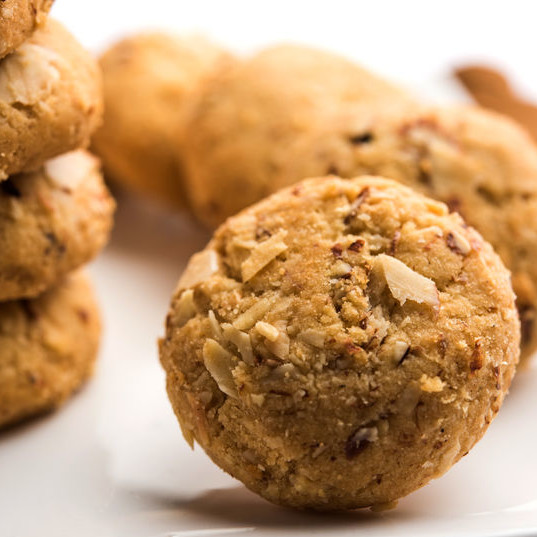
Gluten-free Cookies
What are Gluten-free Cookies?
Gluten-free cookies are sweet, flat baked pieces that are made with gluten-free grains so that the finished product contains less than 20 ppm gluten. They help consumers who suffer from celiac disease, gluten allergies or experience gluten intolerances.1
Types of gluten-free cookies include:
- Chocolate chip cookies
- Flourless peanut cookies
- Shortbread cookies
- Macaroons
- Coconut cookies
How they are made
To formulate gluten-free cookies, it is important to understand the functionalities of gluten and wheat starch during mixing, forming, and baking of conventional wheat-based cookies.
Ingredients that can replace the structural-setting functionality provided by wheat proteins in gluten-free cookies include:2
- Rice flour (brown or white)
- Resistant starch
- Oat flour and gluten-free oat starch
- Maize, sorghum, teff and millet flour
- Tapioca flour, tapioca/potato starches
- Modified or instant starch
- Garbanzo (chickpea) flour
- Pseudocereals (e.g. quinoa, amaranth, buckwheat)
- Soy flour
- Pea protein
- Sodium carboxymethylcellulose (CMC)
- Gums (guar, xanthan, inulin, psyllium husk)
Typical formulation of chocolate chip gluten-free cookies (extrusion forming)
| Ingredient | True % (based on formula weight) |
| Stage 1 (creaming) | |
| Sugar (refined, granulated) | 15.0 |
| Shortening, butter | 20.0 |
| Soy lecithin | 1.0 |
| Stage 2 (liquids addition) | |
| Liquid whole eggs | 6.0 |
| Honey | 2.0 |
| Molasses | 1.0 |
| Vanilla extract | 0.4 |
| Stage 3 (drys) | |
| White rice flour | 15.0 |
| Brown rice flour | 15.0 |
| Resistant starch | 2.5 |
| Tapioca starch | 2.5 |
| Salt | 0.5 |
| Baking powder | 0.3 |
| Inclusions | |
| Chocolate chips | 20.0–30.0 |
Processing
Given the absence of a viscoelastic network normally provided by gluten, most gluten-free cookies are made to have a short and fluid rheology, with particular spread responses. These two conditions are best suited for extrusion and wire-cut forming.
- Ingredients scaling
- Mixing (multi-stage method)
- Creaming
- Addition of liquids
- Add in dry ingredients
- Addition of chocolate chips at low speed until full incorporation
- Forming
- Baking. Bake the product in a batch-type, gas-fired oven at 392°F / 200°C for 6 to 7 minutes. Baking times and temperatures are usually consistent with those used to bake wheat-containing counterparts.
- Cooling. Cool cookies for at least 1.5 times the baking time.
- Packaging
Application
Gluten-free cookies are relatively easy to formulate given the non-essential role of gluten in such food matrices compared to other baked products. In wheat-based cookies, gluten development is very limited due to the prevalence of sugars and fats and reduced level of water required for hydration of flour solids. These conditions allow for a greater diversity of ingredient options that can be used in gluten-free cookies production.
Recommendations for product design
- Simple trial and error using test versus control experiments
- Run statistically designed experiments to identify and optimize ingredients and processing steps to replace wheat flour
- Use texture assessment tools like hardness, color (Hunter L, a, b), height and spread as KPI for formula optimization
- Apply the spread factor for formula and process optimization. This is key for testing alternative flours and starches, balancing sugar/shortening ratio and establishing optimum baking conditions (e.g. damper settings for steam extraction).
- Alternative dry and/or liquid forms for sugar and eggs can always be used. Amount of total solids and water provided by each ingredient form must be taken into account when balancing total formula absorption.
References
- U.S. Food and Drug Administration (FDA), Questions and Answers on the Gluten-Free Food Labeling Final Rule, Content current as of 07/16/2018, Questions and Answers on the Gluten-Free Food Labeling Final Rule. Accessed 11 April 2020.
- Casper, J.L., and Atwell, W.A. “Gluten-Free Bakery Product Formulation and Processing.” Gluten-Free Baked Products, AACC International, Inc., 2014, pp. 49–67.

